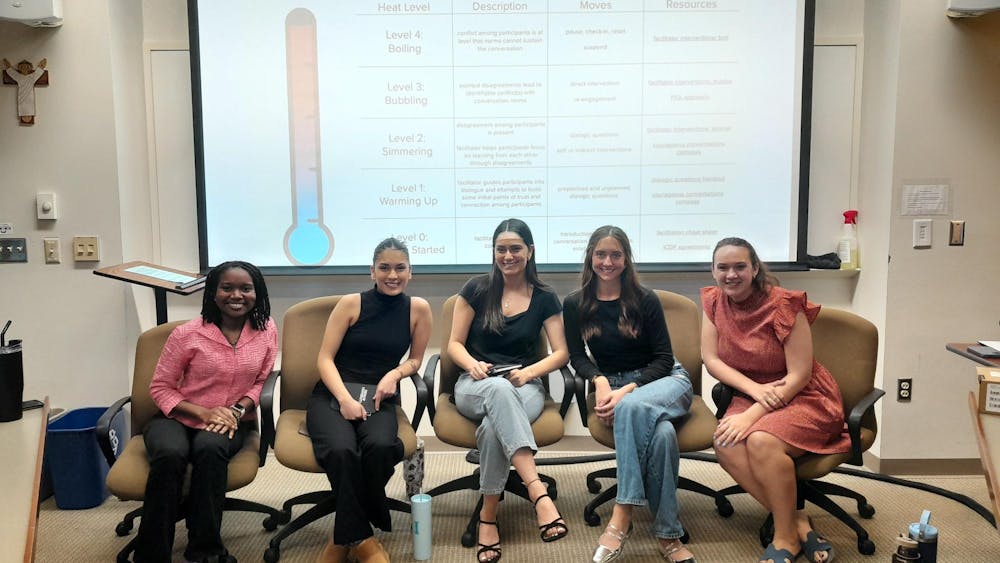Thomas O’Sullivan, assistant professor of electrical engineering at Notre Dame, is the leader of a research group focused on biomedical engineering. Over the past year, his team has worked with light in order to study tissue and measure the effects, progression and early signs of disease.
This project stemmed from an idea proposed by Roy Stillwell, a graduate student getting his doctorate in electrical engineering. He is the CEO and chief scientist for NearWave, which focuses on developing a handheld, wireless frequency-domain diffuse optical spectroscopy platform.
Stillwell explained that in one of O’Sullivan’s classes last year, he was instructed to complete a mock National Institutes of Health (NIH) grant proposal on an idea related to biophotonics, or the study of biology and light. After writing a grant with colleague Vincent Kitsmiller, the two decided they could convert their writing into action. With internal funding, their idea manifested into the optical imager they now have.
This optical imager uses the body as a light guide — its technique of observing how light impacts the body allows doctors to conclude the cells’ metabolic and tissue status. O’Sullivan explained why light is used in this process.
“The reason to use light is that it is inherently a safe type of imaging modality,” O’Sullivan said. “It doesn’t use ionizing radiation as an X-ray does and it doesn’t require injecting a drug or a dye that provides contrast.”
Ola Salahaddin Alfahal Abdalsalam, a graduate student studying electrical engineering, also works in O’Sullivan’s lab. She elaborated on the science behind the imager.
“[This device] uses infrared light, which is less harmful to the sun,” Abdalsalam said. “When you do X-Ray imaging or CT scans, you’re exposing the patient and the technician to this ionizing radiation which, in the long term, could have an impact on their health.”
Given these facts, Abdalsalam said the lab‘s technology offers a safer way to get information about the disease in cases where stronger scans are not needed.
Sophomore Alex Beck, who is studying electrical engineering, worked in the lab as well. He described the limits of the optical imager, despite the rapid health evaluation it allows for.
“The big difference between our technology and MRI CT scans is that MRI CT scans are very high-resolution images and you can go much deeper into the body with them,” Beck said. “Ours works with low-resolution optics.”
O’Sullivan also spoke to the codependent nature of this device.
“This technology provides more information than the doctors currently have access to right now,” he said.
Abdalsalam discussed this complementary technology by drawing attention to the existing types of imaging.
“There is functional imaging, which tells you the concentration or composition of things, and structural imaging, which tells you exactly where everything is.”
The lab’s optical imager falls into the functioning category, while MRIs and CTs fall into the structural category.
Balancing new technology and old, O’Sullivan foresees improved approaches to illness in the medical field.
“In combination with the other tools doctors already have, it will certainly help to improve the accuracy of both diagnosis and monitoring response to treatment,” O’Sullivan said.
Discussing the impact this could have on individuals, O’Sullivan acknowledged that America’s medical expenses remain a complex political and economic problem. Even so, this technology offers new hope for those struggling with medical bills.
“In our medical system, [the optical imager] is meant to be an adjunct imaging modality to offer further intel,” O’Sullivan said.
To explain this balance of scanning technologies, O’Sullivan referred to breast cancer, for which women are encouraged to get tested regularly.
Because mammograms do not have great accuracy, he said, on average, only one in three women who get anomalous breast biopsy results actually have a malignant tumor.
O’Sullivan said he believes it is best to be conservative in approaching cancer scans, in order to ensure the illness is detected at its early stages.
However, in the example he provided, possibly inaccurate mammograms could burden patients with additional costs, anxiety, pain and potential bruising. On the other hand, an optical imager would offer rapid results and a painless procedure.
But this device is not limited to detecting diseases. In terms of chemotherapy — treatment in which tumors are not taken out but are instead targeted — the optical imager could be used to track treatment effectiveness.
“We’ve got very strong data, and my colleagues at other universities who look at similar problems see that [with this device,] we can see whether a tumor is responding to that treatment very early on, perhaps even as soon as a day or a few days after that first chemotherapy infusion,” O’Sullivan confirmed.
It is in cases like this that the optical imager can spare women weeks of rigorous, toxic chemotherapy treatment.
“[They can] get a treatment that’s going to benefit them more than it’s going to hurt them,” O’Sullivan said.
While this device can facilitate medical tests and procedures, it can also help patients maintain financial stability while undergoing treatment.
Stillwell noted that their team “can build these technologies for $1,000 or even less.”
Compared to standard X-rays — which range from $100,000 - $200,000 — and MRIs — which cost around $1,000,000 — an optical imager can allow patients to keep track of their health and identify possible diseases while avoiding these high costs.
“The cost of an imaging scan with the optical imager device is on order for $10,” Stillwell said.
Abdalsalam noted the accessibility of this technology.
“We are trying to get this to be accessible in clinical setups, so it’s easier to get it at the clinic itself, rather than traveling to the hospital,” she said.
O’Sullivan commented that there is even a potential for this device to be on the consumer market, but he does not want this tool to allow someone to avoid a specific treatment if they would otherwise benefit from it.
“The thing you have to verify is if the way you use the information you get from the technology is safe,” he said.
Still, for him, “the next step is in a potential consumer application, at least in breast cancer cases, to provide an at-home screening tool for family members who are at a high risk of developing a disease.”
Therefore, the optical imager should be used to detect disease and treatment effectiveness, not provide individuals insight into beneficial treatment methods.
Although he referenced application benefits in breast cancer cases, O’Sullivan said that this device’s applications are not limited to breast cancer or diseases. He said the optical imager could also be used to get a perspective on health, wellness, exercise training and weight loss.
“This device measures changes in tissue composition so you can watch fat cells get smaller, which can be used to both encourage and optimize right weight loss,” O’Sullivan said. “Conversely, in strength training, it can also be used to see muscle mass essentially get larger.”
As technology continues to evolve, it provides greater transparency in health, allowing individuals to stay updated on their body’s condition.
Regarding the optical imager’s capabilities, O’Sullivan noted that it “goes beyond monitoring good health.”
In addition to assessing blood flow changes, like these technologies do, an optical imager would allow individuals to monitor fat and water concentration changes.
Stillwell also talked about the timeline of the project.
“We have all of the design work done for the prototype and are finishing the build of that prototype; we’re just testing it now,” he stated.
Stillwell said the prototype would be working in the next month and they would be, hopefully, ready to send it out to their research colleagues within the next couple of months.
Sophomore Alex Beck reiterated the project’s purpose.
“I think the goal of any research, especially in the biomedical field, is not just to keep it in a research lab or academic circles,” he said. “The reason people do research is to make products that can have a true impact on people’s lives.”













